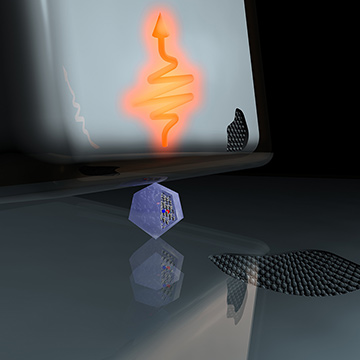 Artist’s representation of a nanodiamond containing a single nitrogen-vacancy (NV) center, coupled to a plasmonic nanoantenna made of crystalline low-loss silver. The antenna–NV system is the brightest single-photon source performing at room temperature. [Enlarge figure]
Artist’s representation of a nanodiamond containing a single nitrogen-vacancy (NV) center, coupled to a plasmonic nanoantenna made of crystalline low-loss silver. The antenna–NV system is the brightest single-photon source performing at room temperature. [Enlarge figure]
Quantum networks promise the advent of secure communication, backed up by the laws of quantum physics. They can also bring distributed quantum computing a step closer to reality. Photonic quantum technologies1 are at the forefront of today’s engineering due to their potential to make long-distance distribution of entanglement and transmission of quantum information an everyday reality.
In contrast to other quantum systems, single photons can carry quantum information in their many degrees of freedom, protect that information from decoherence, and transport it at the speed of light across large distances. More importantly, photonic quantum technologies can leverage the existing infrastructure for classical integrated photonics, which is particularly attractive for commercial applications. In our work published this year, we have advanced the goal of photonic quantum networks by demonstrating the brightest single-photon emission at room temperature to date.2
In many ways, practical success for quantum photonics hinges on the availability of suitable single-photon sources. Epitaxial quantum dots coupled to photonic cavities have functioned as nearly ideal single-photon sources, but they must be operated at liquid-helium temperatures. Another class of single-photon sources, based on nonlinear photon generation, operates at room temperature, but these sources suffer from the inherently nondeterministic nature of the single-photon production.
A room-temperature, high-speed, on-demand single-photon source is highly desirable. However, due to phonon broadening, room-temperature quantum emitters cannot be efficiently interfaced with high-Q photonic cavities, which are crucial components in cryogenically cooled single-photon sources. Plasmonic nanoantennas are attractive alternatives to photonic cavities for speeding up spontaneous quantum emission at room temperature, because rather than relying on a high quality factor, these nanoantennas act by deep subwavelength confinement of the optical modes. However, until recently, plasmonic nanoantennas have been believed to suffer from heavy optical losses and deemed incapable of efficiently enhancing the intensity of single-photon emission.
In our work this year, we employed nanoantennas made entirely from crystalline silver, a plasmonic material with record-low optical losses in the visible range. By embedding photostable single nitrogen-vacancy (NV) centers in nanodiamonds into these nanoantennas, we achieved room-temperature emissions topping at 30 million detected photons per second.
This work opens tremendous opportunities in manipulating emission from room-temperature quantum sources. The prospects include the emission of indistinguishable single photons (given a sufficient shortening of the fluorescence lifetime) and, eventually, the realization of high-speed, room-temperature quantum networks.
Researchers
Simeon I. Bogdanov, Alexei S. Lagutchev, Chin-Cheng Chiang, Deesha Shah, Alexander V. Kildishev and Alexandra Boltasseva, Purdue University, West Lafayette, Ind., USA
Mikhail Y. Shalaginov, Massachusetts Institute of Technology, Cambridge, Mass., USA
Aleksandr S. Baburin and Ilya A. Rodionov, Bauman Moscow State Technical University, Moscow, Russia
Ilya A. Ryzhikov, ITAE RAS, Moscow, Russia
Vladimir M. Shalaev, Purdue University and Birck Nanotechnology Center, West Lafayette, Ind., USA
References
1. J.L. O’Brien et al. Nat. Photon. 3, 687 (2009).
2. S.I. Bogdanov et al. Nano Lett. 18, 4837 (2018).
